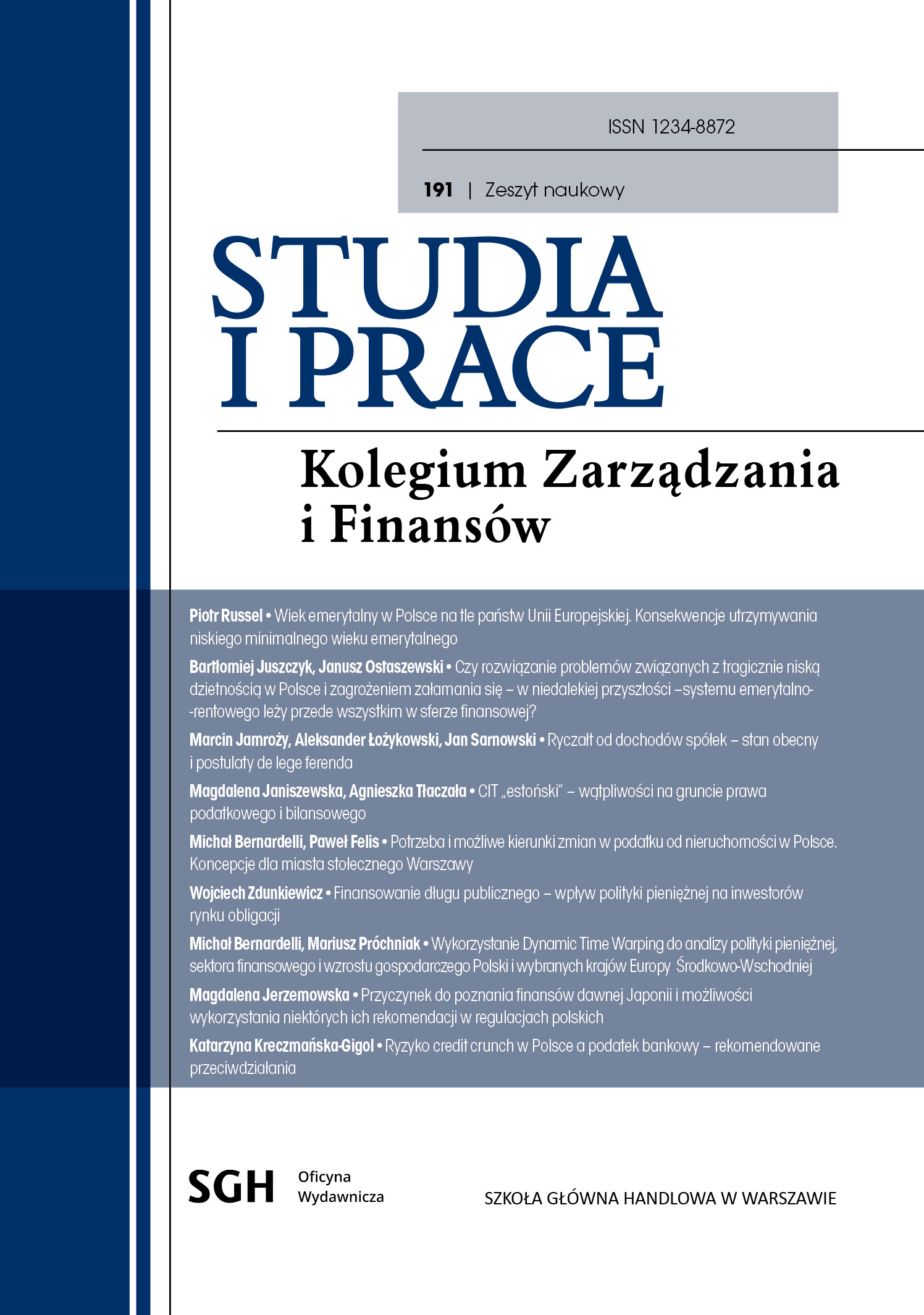Public debt financing: the impact of the monetary policy on bond market investors
DOI:
https://doi.org/10.33119/SIP.2023.191.6Keywords:
debt market, pandemic crisis, inflationary shock, investor, unconventional monetary policy instrumentsAbstract
The aim of the article is to present the impact of the monetary policy of the National Bank of Poland, implemented in response to the pandemic crisis (the catalogue of unconventional instruments), as well as during a period of increased inflation on investors in the bond market. The analysis will encompass the characteristics of the debt market that are relevant to investors, that is the supply of new issuances, yield levels, and regulatory requirements. The point of reference is the capital flow in terms of the changing with time structure of buyers resulting from the observed changes in the studied characteristics. The assessment of monetary policy actions, in particular, including unconventional instruments, and the response to significant inflation growth contributes to the theoretical interpretation of the consequences of these actions, which are undertaken in the current mainstream economics and interpreted in heterodox theories like the modern monetary theory. The author maintains that the analysis of the consequences of using unconventional monetary policy instruments and the impact of monetary policy during periods of inflationary shocks in the debt market is an important element of the public debt management strategy, which is a component of a stable economic policy for the state. The recommendations formulated in the article concern both the monetary and fiscal policy, as well as financial safety nets. They apply separately to the period of using unconventional instruments and the period of inflation shocks.
Downloads
References
1. Aizenman J., Zheng H. [2023], Inflation Surge and Sovereign Borrowing: The Role of Policy Practices in Strengthening Sovereign Resilience, NBER Working Paper, nr 31173.
2. Andrews D., Petroulakis F. [2019], Breaking the Shackles: Zombie Firms, Weak Banks and Depressed Restructuring in Europe, ECB Working Paper Series, Frankfurt a. M.
3. Dębski W. [2012], Rynek finansowy i jego mechanizmy, Wydawnictwo Naukowe PWN, Warszawa.
4. Duca M.L., Nicoletti G., Martinez A.V. [2016], Global Corporate Bond Issuance: What Role for US Quantitative Easing?, „Journal of International Money and Finance”, 600.
5. Fratto C., Harnoys Vannier B., Mircheva B., de Padua D., Poirson D. [2020], Unconventional Monetary Policies in Emerging Markets, „IMF Working Paper”, WP/21/14.
6. Grostal W., Ciżkowicz-Pękała M., Niedźwiedzińska J., Skrzeszewska-Paczek E., Stawasz E., Wesołowski G., Żuk P. [2015], Ewolucja strategii celu inflacyjnego w wybranych krajach, NBP, Warszawa.
7. Kemoe L., Zhan Z. [2018], Fiscal Transparency, Borrowing Costs, and Foreign Holdings of Sovereign Debt, „IMF Working Papers”, WP/18/189.
8. Lustenberger T., Rossi E. [2020], Does Central Bank Transparency and Communication Affect Financial and Macroeconomic Forecasts, „International Journal of Central Banking”,
9. McKinnon R. [2011], Where Are the Bond Vigilantes? „Wall Street Journal”, https://www. hoover.org/sites/default/files/wsj-bond-vigilantes_ron-mckinnon.pdf, dostęp: 24.04.2023.
10. Rubio M., Unsal D.F. [2017], Macroprudential Policy, Incomplete Information and Inequality: The Case of Low-Income and Developing Countries, „IMF Working Paper Series”, WP/17/59.
11. Rzońca A. [2014], Kryzys banków centralnych. Skutki stopy procentowej bliskiej zera, C.H.Beck, Warszawa.
12. Rzońca A., Parosa G. [2020], Unconventional Monetary Policy Is Not a Free Lunch in Europe or the United States, https://www.atlanticcouncil.org/blogs/new-atlanticist/unconventional-monetary-policy-is-not-a-free-lunch-in-europe-or-the-united-states/, dostęp: 24.04.2023.
13. Strategia zarządzania długiem, Ministerstwo Finansów, https://www.gov.pl/web/finanse/strategie-zarzadzania-dlugiem
14. Styn I. [2010], Banki na rynku długoterminowych dłużnych papierów wartościowych, w: Bank na rynku finansowym. Problemy skali, efektywności i nadzoru, red. E. Miklaszewska, Wolters Kluwer Polska, Warszawa.
Materiały internetowe
1. https://www.eba.europa.eu/risk-analysis-and-data/risk-dashboard
2. https://www.gov.pl/web/finanse/majowa-oferta-oszczednosciowych-obligacji-skarbowych2
3. https://www.gov.pl/web/finanse/struktura-inwestorow
4. Ministerstwo Finansów, https://www.gov.pl/web/finanse/zadluzenie
5. NBP, https://nbp.pl/polityka-pieniezna/dokumenty-rpp/informacje-po-posiedzeniach-rpp/
6. Obligacje Skarbowe, https://www.obligacjeskarbowe.pl/









